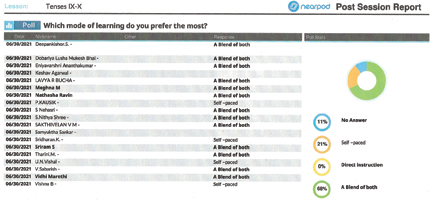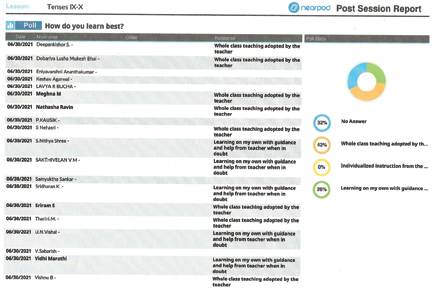B. Ajitha
Though learners of English as a second language are introduced to the concept of tenses in the primary classes and the forms are reinforced by practice all through middle school, it is observed that a majority of students in high school display a lack of mastery in the use of the tenses, which is discernible in writing as well as speaking.
Objectives
The purpose of this study was: a) to investigate the reason for the learning gap as mentioned above in the adept use of the tenses b) to learn about their preferred style of learning and design an intervention in line with their learning needs, level of readiness and previous knowledge.
This study was undertaken during the preliminary phase of action research, wherein the learning need gauged by student responses helped determine the nature of intervention to address the problem identified.

Collection of data
An online poll consisting of a pre-determined set of questions was designed using Nearpod and administered to students of classes IX and X to find out from them their knowledge of the tenses.
Analysis
The poll results are given below in the form of question-wise analysis:
a. A majority of the students admitted to not being confident in the correct use of the tenses either in speech or writing.
b. Nearly half the students surveyed expressed the need to be taught tenses from the basics.
c. Almost all the participants indicated their preference for taking up one form of the tense at a time and proceed to the next form only on attaining mastery in the tense taken up.
d. A majority of students desired a blend of direct instruction, whole class teaching and self-paced learning using curated learning resources created by the teacher as their preferred choice of learning mode.
e. A little less than half of those surveyed voiced their support for whole class teaching used all the time by the teacher in conventional teaching with about a sizable percentage preferring self-paced and self-directed learning with guidance of the teacher whenever in doubt.
f. Surprisingly none of the students seemed to feel the need for personalized instruction necessitating one-on-one individualized attention. Some others did not have an answer, implying they never thought of an alternative mode of teaching-learning being possible.
g. Not having explored asynchronous, self-paced and blended learning resources specially designed for remote learning pre-pandemic, students had a mixed response to their own assessment of the effectiveness of blending learning.

Intervention
Based on the analysis of the data from the instant poll, it was clear that the traditional ‘chalk and talk’ pedagogy has been ineffective in realizing the learning objectives while teaching grammar – specifically, the tenses.
Harnessing the benefits of digital tools in use during virtual teaching, an interactive teaching-learning resource was created on Nearpod with the following objectives:
a. To grab the attention of the learners while the topic is introduced and keep it sustained throughout so that they remain invested in the learning process.
b. To allow the learners to process information at a pace comfortable to them.
c. To use formative assessment to gauge learning outcomes while the learning is in progress for remedial action.
d. To provide instant feedback on learning through interactive quizzes.
e. To ensure mastery of forms by incorporating exit tickets to mark progression from one form to the other.
f. To hold students accountable for taking ownership of their learning.
g. To making learning fun and interesting by incorporating AV content and interactive activities and providing instantaneous feedback.
Intervention design
A teaching-learning resource designed for blended learning (synchronous-live either in person or virtually where all the students of a particular class are together at the same time and the teacher facilitates learning and asynchronous – students continuing to learn after class, working on assignments/tasks given by teachers) used for both direct instruction and self-paced learning was created on Nearpod.

The overall design of the module broke down the tenses and their forms into bite size learning modules with focus on each of the tenses separately as delineated below:
a. A well designed YouTube tutorial on the tenses was selected that gave a comprehensive coverage of the tenses with adequate examples illustrating the rules that govern the correct usage (conditions, functions and exceptions).
b. After watching each segment of the AV content covering one form of the tenses at a time from the tutorial, learners had to take an interactive quiz inbuilt in the module to test their retention. This ensured that the learners were attentive and truly interacted with the content to internalize the tenets governing the use of the form.
c. The progression from one form to another was clearly demarcated and students followed a linear progression determined by the overall design of the module and controlled by the teacher while using the live participation mode.
d. The end of the module had a mixed bag of questions to test the students on all the tenses learned throughout the module.
e. The same resource when shared in student-paced mode gave the students access to the content to be gone over anytime they wanted and practice the quiz question all over again at their own leisure.

Findings
a. The intervention planned to harness the benefits of blended teaching-learning through design of resource capturing the essence of a topic presented in a visually appealing manner ensured that the usual passive engagement from the students was transformed into an active learning experience for all the students who attended the virtual class.
b. Use of blended learning as pedagogy proved to have versatile functions like:
i. Activities/practice exercises could be used synchronously in class while teaching to trigger curiosity and initiate discussion at the start of a new topic/session.
ii. As a teaching aid to recapitulate or conduct formative assessments to check for understanding and gauge the learning outcome at the end of each sub-topic.
iii. The same set of resources when used asynchronously, (that is, assigned as offline work to be accessed by students at their leisure promotes self-paced learning).
iv. Thus, a blend of synchronous and asynchronous is more effective in realizing the learning objectives and bettering learning outcomes.
Conclusion
a. The preliminary data on the engagement level of students obtained from students’ feedback make a compelling case to continue with creation and use blended learning resources specially to reinforce grammar concepts.
b. Generating learning resources that give the distilled essence in an easily digestible form and which is at the same time interactive and interesting to engage with has a better chance of achieving MLL (minimum level of learning) rather than prosaic worksheets especially with students requiring additional reinforcements due to differential learning needs.
The author teaches English and Life Skills to students of senior and senior secondary classes at Delhi Public School, Coimbatore. She also designs, coordinates and oversees the in-service training programme at Delhi Public Schools – Patna, Pune, Ludhiana and Coimbatore under the aegis of Takshila Educational Society. She can be reached at ajithabashkar@gmail.com.
